How to Fertilize Peach Trees: Expert Advice for Superior Yield
- April 19, 2024
- 0 comment
Learn how to fertilize peach trees with our expert advice for superior yield. Discover the best times, techniques, and nutrients for thriving trees. Achieving a plentiful and healthy peach harvest requires more than just water and sunlight; it demands expert knowledge on fertilization. In this comprehensive guide, we delve into the essential steps to nourish your peach trees effectively.
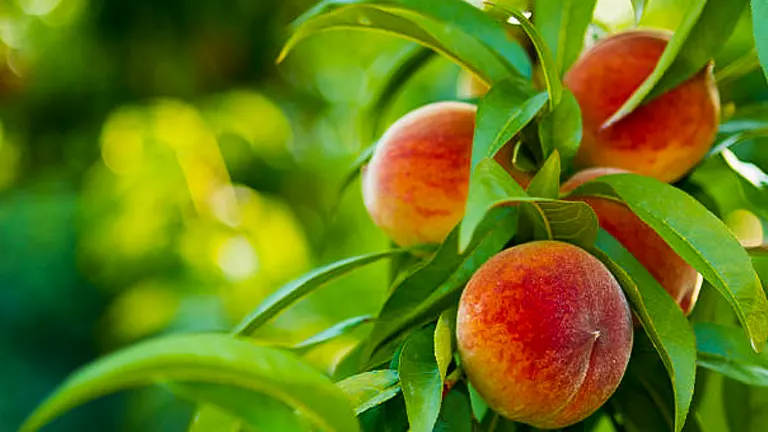
From understanding the optimal fertilization times to selecting the right nutrients, we cover everything you need to know to cultivate flourishing peach trees that produce abundantly. Get ready to transform your gardening approach with our professional tips and watch your peach trees thrive like never before.
Table of Contents
- Understanding Peach Trees and Their Nutrient Needs
- Soil and Nutrient Management
- Fertilizing Your Peach Trees
- Planting and Initial Care
- Monitoring and Adjustments
- Common Mistakes to Avoid
- Seasonal Care and Maintenance
- Advanced Techniques for Enhanced Yield
- Sustainable Practices for Long-term Success
- Future-Oriented Techniques and Innovations
- Conclusion
- FAQs
Understanding Peach Trees and Their Nutrient Needs
Types of Peach Trees
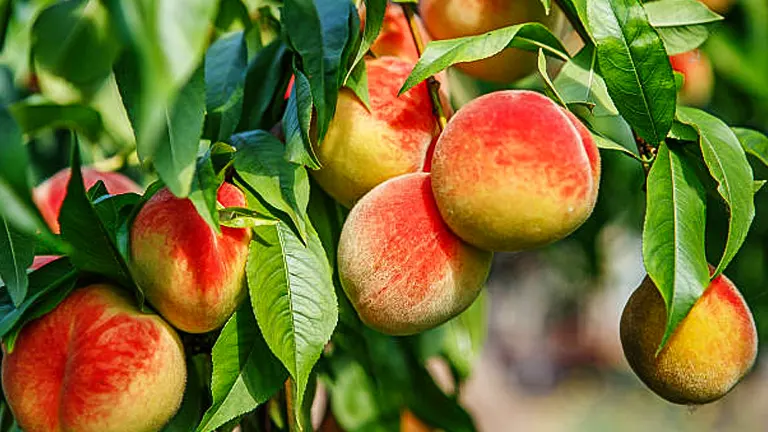
Peach trees are diverse, each variety adapted to specific growing conditions and purposes. Understanding these can help optimize care and fertilization strategies to enhance growth and fruit production.
- Freestone Peach Trees: Varieties like ‘Elberta’ and ‘Red Haven’ produce fruit that easily separates from the pit. They are favored for fresh eating and canning, thriving in both home gardens and commercial orchards.
- Clingstone Peach Trees: ‘Georgia Belle’ and ‘Santa Rosa’ are examples where the fruit flesh clings tightly to the pit, typically used in processed foods like canned peaches.
- Dwarf Peach Trees: Varieties such as ‘Bonanza’ and ‘Garden Gold’ reach about 6 feet tall, ideal for limited spaces and easier harvesting.
- Semi-Dwarf Trees: These grow to about 12-15 feet and are productive, space-efficient options that blend the benefits of full-size and dwarf trees.
Nutrient Requirements
Peach trees demand a balanced diet of macro and micronutrients for optimal health and productivity, detailed in the table below:
| Nutrient | Role | Optimal Amounts |
|---|---|---|
| Nitrogen (N) | Promotes growth of leaves and shoots; essential for vigor. | 50-70 lbs per acre |
| Phosphorus (P) | Supports root development; enhances flowering and fruiting. | 40-60 lbs per acre |
| Potassium (K) | Improves plant health and disease resistance; enhances fruit quality. | 60-80 lbs per acre |
| Calcium (Ca) | Vital for cell wall development and division. | 65-85 lbs per acre |
| Magnesium (Mg) | Necessary for chlorophyll production and photosynthesis. | 20-30 lbs per acre |
| Sulfur (S) | Important for protein synthesis. | 15-25 lbs per acre |
| Iron (Fe) | Essential for chlorophyll synthesis, influences enzyme functions. | 5-10 lbs per acre |
| Manganese (Mn) | Functions as a part of certain enzyme systems. | 2-5 lbs per acre |
| Zinc (Zn) | Vital for starch formation; helps in the synthesis of growth hormone. | 2-5 lbs per acre |
The amounts given are general guidelines and should be adjusted based on soil test results and specific cultivar needs.
Signs of Nutrient Deficiency
Identifying nutrient deficiencies early can prevent productivity losses. Here’s how to recognize common deficiencies:
- Nitrogen Deficiency: Yellowing starts from older leaves; reduced leaf size and stunted growth; poor fruit development.
- Phosphorus Deficiency: Leaves appear unusually dark green; stunted growth; roots are poorly developed.
- Potassium Deficiency: Leaf tips and margins may appear scorched or curled; fruits are small and poorly colored.
- Calcium Deficiency: New leaves are distorted or hook-shaped; blossom end rot; weak root system.
- Magnesium Deficiency: Older leaves show interveinal chlorosis (yellowing between veins) first; leaf edges may curl upward.
- Iron Deficiency: Young leaves show strong interveinal chlorosis; severe cases result in entirely yellow leaves that are thin and brittle.
- Manganese/Zinc Deficiency: Smaller leaves than normal; short internodes; speckled or mottled leaves.
Each nutrient plays a critical role, and deficiencies can seriously impact tree health, affecting everything from leaf color to fruit quality and overall yield. Managing these nutrient levels through careful monitoring, soil testing, and targeted fertilization can ensure your peach trees remain healthy and productive.
Soil and Nutrient Management
Soil Preparation

Preparing the planting site is critical. Start with a soil test to determine pH and nutrient levels. Peach trees prefer slightly acidic soil (pH 6.0-6.5). Amend the soil based on the test results; this may include adding lime to raise the pH or sulfur to lower it.
Understanding Nutrient Needs
- Macronutrients: Nitrogen (N), phosphorus (P), and potassium (K) are essential. Nitrogen promotes leaf and shoot growth, phosphorus supports root and flower development, and potassium aids in overall health and disease resistance.
- Micronutrients: Elements like calcium, magnesium, and zinc are vital in smaller quantities. A balanced fertilizer, often labeled with an NPK ratio such as 10-10-10, typically provides these in adequate amounts.
Soil Testing and Analysis
Soil testing every 1-2 years is advisable. It guides not only the initial amendment needs but also ongoing fertilization practices. If the soil is deficient in a particular nutrient, targeted supplements (like bone meal for phosphorus or potash for potassium) can be applied.
Fertilizing Your Peach Trees
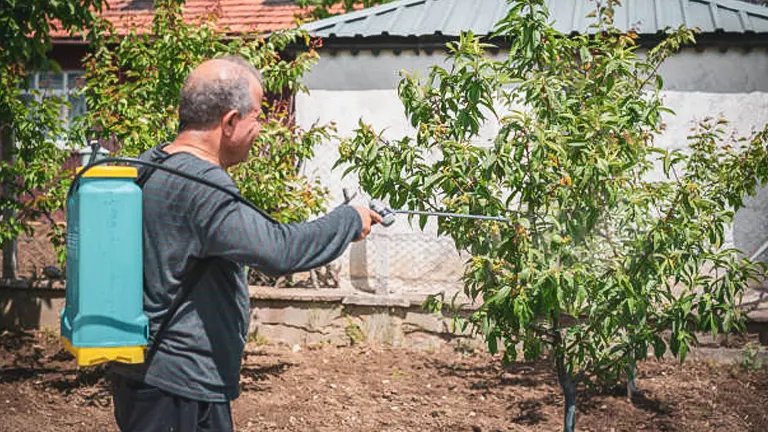
Proper fertilization is crucial to the health and productivity of peach trees. This section provides a comprehensive guide on choosing the right fertilizers, understanding the optimal fertilization schedule, and applying techniques effectively, supplemented by a detailed table of nutrient specifications.
Choosing Fertilizers
Selecting the right type of fertilizer is crucial for the health and productivity of peach trees. Each type offers different benefits:
- Organic Fertilizers: Examples include composted manure, bone meal, and fish emulsion. These materials release nutrients slowly, enriching soil microbiology and structure. They are ideal for young trees, helping establish a robust root system without the risk of nutrient burn.
- Synthetic Fertilizers: These are manufactured chemical fertilizers that provide nutrients in a more readily available form. They are beneficial during critical growth phases when trees demand an immediate nutrient supply, such as fruiting season.
- Controlled-Release Fertilizers: A hybrid approach, these fertilizers encapsulate nutrients in a polymer coating that slowly degrades, releasing contents over time. They offer the quick availability of synthetic fertilizers with the prolonged release of organic options.
Fertilizer Types and Their Application
| Fertilizer Type | Nutrient Release | Best Used For |
|---|---|---|
| Organic | Slow | Soil health, young trees |
| Synthetic | Immediate | Peak growing phases, nutrient deficits |
| Controlled-Release | Gradual | Consistent nutrient supply, all growth stages |
Fertilization Schedule
The fertilization schedule for peach trees varies depending on their growth stage and seasonal needs:
- Initial Application: Integrate a balanced N-P-K (Nitrogen, Phosphorus, Potassium) fertilizer at planting. Aim for a formulation closer to 10-10-10 to support all-around development without overwhelming young roots with nitrogen.
- Maintenance Doses: Fertilize established trees in early spring to kickstart growth, and again post-bloom to support fruit development. A fall application should be lower in nitrogen and higher in potassium and phosphorus to prepare the tree for winter and encourage strong root growth.
Orchard Design
Proper orchard design and tree spacing are pivotal for disease management and nutrient efficiency:
- Density Considerations: Transitioning from traditional to high-density orchards can significantly increase yield per acre. High-density planting requires diligent management practices to ensure tree health and nutrient availability.
- Spacing Guidelines: Ideal spacing varies with the tree’s growth habit and the orchard’s design. High-density plantings might range from 5 to 8 feet between trees within rows and 12 to 16 feet between rows.
Application Techniques
How fertilizer is applied can significantly impact its effectiveness and the tree’s health:
- Broadcasting: Ideal for granular organic and synthetic fertilizers. Apply in a circle around the tree’s drip line, avoiding direct contact with the trunk to prevent nutrient burn.
- Drip Application (Fertigation): Combines irrigation with fertilization, delivering nutrients directly to the root zone. This method is highly efficient, reducing runoff and ensuring that nutrients are where the trees can best utilize them.
- Foliar Feeding: Effective for quick correction of micronutrient deficiencies. Micronutrients such as zinc, manganese, or iron can be applied directly to the leaves for fast absorption.
Scientific Analysis and Considerations
- Soil pH Influence: Soil pH significantly affects nutrient availability. A pH of 6.0-6.5 is optimal for peach trees, allowing for maximum nutrient uptake. Regular soil testing and adjustments are necessary to maintain this balance.
- Nutrient Interaction: Nutrient uptake can be influenced by the presence or absence of other nutrients. For instance, high levels of potassium can inhibit magnesium uptake, critical for chlorophyll production. Balancing nutrient ratios is key to avoiding such antagonistic interactions.
- Microbial Activity: Organic fertilizers improve soil health by enhancing microbial activity, which in turn aids in nutrient breakdown and soil structure. The benefits extend beyond nutrient supply, promoting a healthy root environment conducive to growth.
Planting and Initial Care
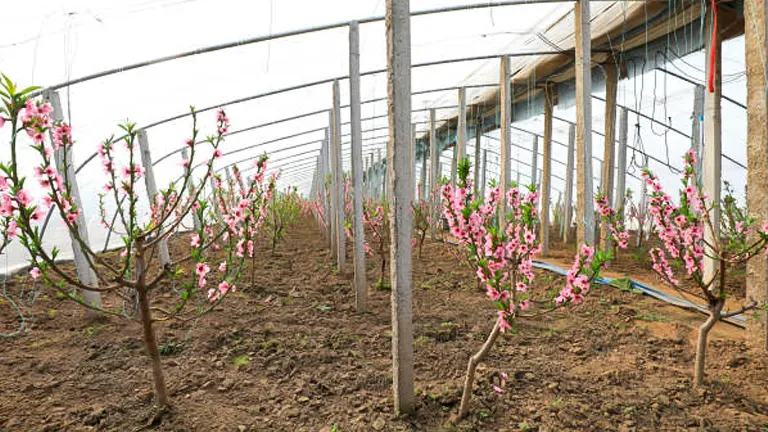
Proper planting and early care are crucial for establishing healthy peach trees and ensuring their long-term success. This section will delve into advanced planting techniques, precise watering strategies, and the benefits of proper mulching and ground cover.
Planting Techniques
The right planting technique sets the foundation for a peach tree’s health and productivity.
- Timing: The best time to plant peach trees is during the dormant season, from late winter to early spring. Planting during dormancy reduces transplant shock and allows roots to establish in cool temperatures, which promotes strong early growth.
- Hole Preparation: Prepare a hole that is twice as wide as the root ball and exactly as deep. This allows the roots to spread easily without crowding, encouraging better establishment and access to nutrients.
- Root Placement and Backfilling:
- Root Placement: Set the tree so that the graft union (the point where the scion meets the rootstock) is approximately 2 inches above the soil level. This prevents root diseases and ensures the scion does not root itself, which could negate the benefits of the rootstock.
- Backfilling: Mix native soil with compost or aged manure to backfill the hole. This mixture improves soil fertility and texture. Tamp down lightly to eliminate air pockets but avoid compacting the soil, which can hinder root growth.
- Watering: Immediately after planting, water the tree generously to settle the soil around the roots and alleviate any stress from transplanting. Establish a regular watering schedule of deep watering once a week, adjusting for rainfall and soil type to maintain optimal moisture levels.
Planting Specifications for Peach Trees
| Aspect | Details |
|---|---|
| Best Planting Time | Dormant season (Late winter to early spring) |
| Hole Size | Twice the width and same depth as the root ball |
| Graft Union Height | 2 inches above soil level |
| Watering Needs | Generously post-planting, then once a week or as needed |
Water Management and Mulching
Proper hydration and soil care are key in the first few years of a peach tree’s life, which significantly impact its health and fruit production.
- Drip Irrigation: This system delivers water directly to the soil at the roots, minimizing evaporation and ensuring that water is not wasted. Drip irrigation is particularly efficient for maintaining consistent soil moisture and is beneficial in regions prone to drought.
- Mulching:
- Purpose: Mulch conserves moisture, helps regulate soil temperature, and suppresses weeds.
- Materials: Use organic materials like shredded bark, pine straw, or leaf mold. These not only retain moisture but also gradually break down to enrich the soil.
- Application: Apply a 2-3 inch layer around the base of the tree, extending out to the drip line. Avoid direct contact with the trunk to prevent rot.
Water Management and Mulching Techniques
| Technique | Function | Recommended Practice |
|---|---|---|
| Drip Irrigation | Delivers water directly to roots, conserving moisture | Install lines near root zone; adjust flow as needed |
| Mulching | Conserves moisture, regulates soil temp, suppresses weeds | Apply 2-3 inches around drip line; avoid trunk contact |
Ground Cover
Incorporating ground cover plants around peach trees can improve orchard health and aesthetics.
- Benefits:
- Soil Health: Ground covers prevent erosion and improve soil structure. Plants like clover or alfalfa fix nitrogen in the soil, reducing the need for chemical fertilizers.
- Weed Suppression: Dense planting of ground covers can outcompete weeds, reducing the need for herbicides.
- Water Retention: Ground covers help retain soil moisture, which is especially beneficial in dry conditions.
- Recommended Ground Covers:
- Clover: Fixes nitrogen and attracts beneficial insects.
- Alfalfa: Deep roots break up soil and improve its fertility.
- Fescue: Tolerates low mowing and provides excellent ground cover without competing aggressively with the trees.
Ground Cover Options and Benefits
| Ground Cover | Benefits | Notes |
|---|---|---|
| Clover | Nitrogen fixation, attracts pollinators | Plant in early spring; mow to prevent seeding |
| Alfalfa | Deep roots improve soil structure, fixes nitrogen | Cut back annually to rejuvenate plants and prevent overgrowth |
| Fescue | Durable, low maintenance | Mow to keep short; ensure it doesn’t compete with tree roots |
Monitoring and Adjustments
Observation
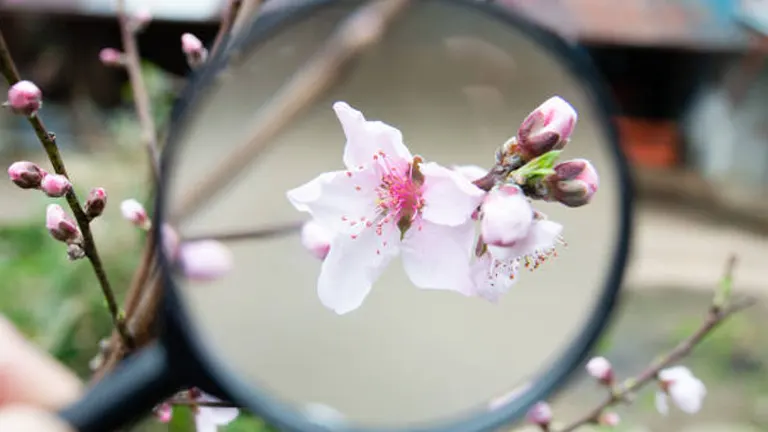
To ensure your peach trees remain healthy and productive, regular monitoring is key. Observing your trees closely allows you to react swiftly to any signs of distress or disease.
- Growth and Health Indicators: Regularly check for robust leaf development, sturdy branches, and vibrant blossoms. Signs such as wilted leaves, stunted growth, or discolored foliage can indicate nutrient deficiencies or pest problems.
- Soil Condition: Keep an eye on the soil’s moisture and nutrient levels. Dry, cracking soil or waterlogged conditions can lead to root diseases.
- Pest and Disease Inspection: Look for signs of pest infestations or fungal diseases, such as holes in leaves, powdery mildew, or fruit that doesn’t mature properly.
Adjustments might be necessary based on what you observe:
- Fertilization Adjustments: If trees show signs of nutrient deficiency (yellow leaves for nitrogen shortage, for instance), increase the specific nutrient during the next fertilization cycle. Conversely, signs of over-fertilization (such as excessively lush growth or salt buildup in the soil) require reducing the fertilizer application.
- Watering Adjustments: Alter your irrigation practices based on weather conditions, tree needs, and soil moisture content. Inadequate water can stress trees, while too much water can suffocate roots, leading to root rot.
Proactive Care and Adjustments
Maintaining the health of your peach trees involves proactive practices to ensure optimal growth conditions and timely interventions to correct any adverse developments.
- Mulching and Soil Health: Refresh mulch layers annually to suppress weeds and maintain soil moisture. Consider green manuring and cover crops to enhance soil fertility and structure.
- Pruning Adjustments: Adjust your pruning technique based on the tree’s age and health. Younger trees may need more formative pruning to establish a strong structure, while older trees might require more aggressive pruning to rejuvenate growth and fruit production.
Common Mistakes to Avoid
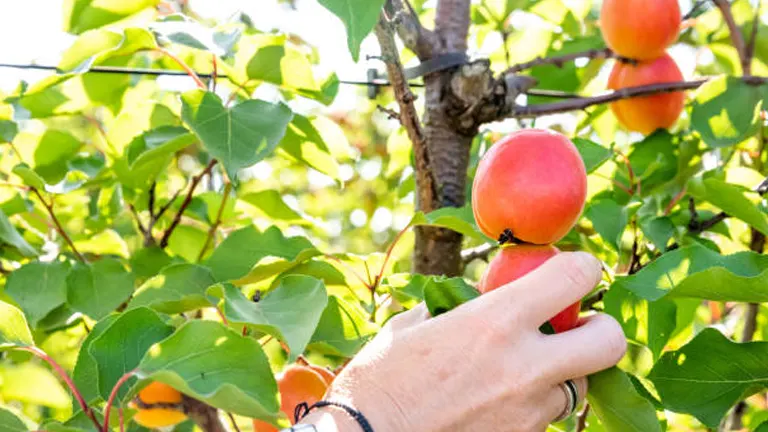
Even with meticulous care, there are common pitfalls that can undermine the success of your peach orchard.
Over-Fertilization
It’s a common mistake that can lead to lush, green growth at the expense of fruit production. Over-fertilization can also cause nutrient imbalances and salt accumulation in the soil, which can burn roots and reduce fruit quality.
- Symptoms: Dark green leaves, reduced flowering, poor fruit set, and salt crusts on the soil surface.
- Resolution: Reduce fertilizer applications, increase irrigation to flush out excess salts, and possibly apply gypsum to help leach the soil.
Under-Fertilization
Insufficient nutrients can stunt tree growth and limit fruit production. Recognizing the signs early helps prevent long-term damage.
- Symptoms: Light green to yellow leaves, small leaves, slow growth, and small fruit.
- Resolution: Conduct a soil test to determine which nutrients are deficient and adjust your fertilizer program accordingly.
Ignoring Pruning Needs
Neglecting to prune peach trees can lead to overcrowded, unhealthy trees with poor air circulation, which increases susceptibility to pests and diseases.
- Symptoms: Dense canopy, low light penetration, poor fruit quality.
- Resolution: Establish a regular pruning schedule. Remove dead or diseased wood promptly, thin overcrowded branches, and open up the canopy to improve air circulation and light exposure.
Water Management Errors
Both overwatering and underwatering can stress peach trees, making them more prone to disease and reducing their lifespan.
- Symptoms: Wilting leaves with overwatering; dry, brittle leaves with underwatering.
- Resolution: Use a drip irrigation system for consistent, measured watering. Adjust watering based on rainfall, temperature, and soil moisture content.
Seasonal Care and Maintenance
Optimal care for peach trees varies with the seasons. Each period demands specific practices to prepare the trees for the next phase of growth or dormancy, ensuring they remain vibrant and fruitful.
Spring Care
- Fertilization: Early spring is when peach trees need a boost to support blossoming and leaf development. Apply a balanced fertilizer with a higher concentration of nitrogen to promote vigorous growth.
- Pruning: Prune before new growth starts. Focus on removing any dead or diseased branches to enhance air circulation and light penetration, which are crucial for fruit set and quality.
- Pest Control: Implement integrated pest management early in the season to control insects like aphids and peach borers that can damage young shoots and fruits.
Summer Care
- Watering: Increase irrigation as temperatures rise and fruits swell. Peach trees need consistent moisture during fruit development for optimal growth and yield.
- Thinning Fruits: Thin out excess fruits in early summer. This practice avoids overburdening the branches and promotes the growth of larger, healthier fruits.
- Weed Management: Keep the area around the trees weed-free to reduce competition for nutrients and water. Mulching also helps retain soil moisture and control weeds.
Fall Care
- Post-Harvest Fertilization: After fruiting, apply a potassium-rich fertilizer to help trees recover and prepare for winter. This step is vital for strengthening the trees’ resistance to cold.
- Preparation for Dormancy: Gradually reduce watering to harden off the trees for winter. Clear the base of the trees of any fallen leaves or debris to prevent fungal diseases.
- Pest and Disease Inspection: Check for signs of pests and diseases after leaf fall, and apply appropriate fungicides or insecticides to manage any infections before they can overwinter.
Winter Care
- Pruning: Late winter is ideal for major structural pruning. Removing older branches encourages new growth and fruiting wood.
- Protection: In colder regions, wrap the trunk with tree guards to protect against frost and rodent damage.
- Soil Tests: Conduct soil tests to assess nutrient needs for the upcoming growing season. Adjust soil amendments based on test results to prepare for spring.
Advanced Techniques for Enhanced Yield
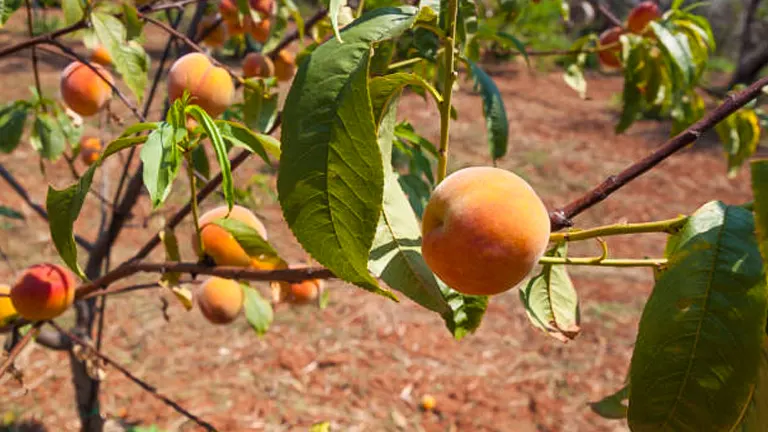
To further improve the quality and quantity of your peach harvest, consider these advanced horticultural techniques:
Grafting
- Purpose: Grafting allows you to combine traits from two different peach varieties, enhancing disease resistance, and adapting to local soil and climate conditions.
- Method: Use compatible rootstocks and scion wood from desired varieties. The best time for grafting is late winter, just before spring growth begins.
Hydroponic Systems
- Benefits: Growing peach trees hydroponically can drastically reduce pest problems and soil-borne diseases. It allows for precise control over nutrients and water, potentially increasing fruit quality and yield.
- Setup: Use inert growing media and a nutrient film technique system for best results. Ensure that the system can support the size and weight of mature peach trees.
Use of Biostimulants
- Advantages: Biostimulants enhance nutrient absorption, improve soil health, and boost natural defenses against stress and diseases.
- Application: Apply seaweed extracts, humic acids, or microbial inoculants during critical growth phases such as blooming and fruit set.
Sustainable Practices for Long-term Success
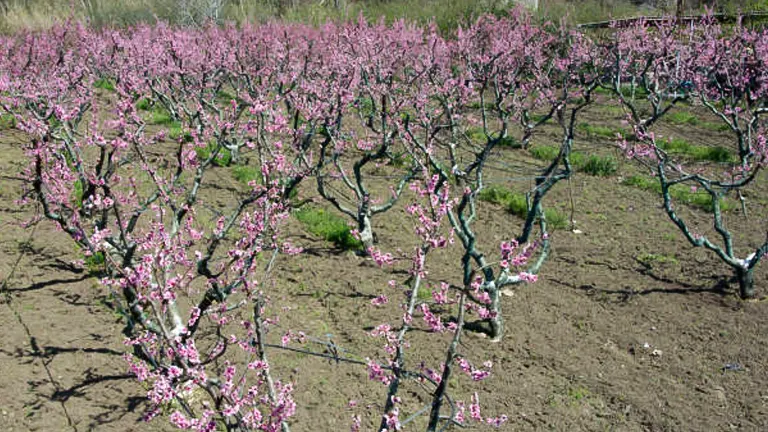
Sustainable agriculture practices not only support environmental health but also enhance the quality and yield of crops such as peach trees. Here are key strategies to implement sustainable methods in your peach orchard.
Integrated Pest Management (IPM)
- Strategy: IPM combines biological, cultural, and chemical practices to control insect pests and diseases while minimizing reliance on synthetic pesticides.
- Implementation: Use pheromone traps for monitoring pest populations, introduce beneficial insects like ladybugs to control aphids, and apply organic pesticides as a last resort. Regularly inspect trees for early signs of disease and address them promptly to prevent spread.
Organic Fertilization and Composting
- Composting: Create a compost pile with organic waste such as fallen leaves, fruit scraps, and manure. This enriches the soil and reduces waste.
- Organic Fertilizers: Use compost, manure, or commercially available organic fertilizers that release nutrients slowly, improving soil structure and fertility without the harsh effects of chemicals.
Water Conservation Techniques
- Mulching: Apply organic mulch around the base of trees to reduce evaporation and suppress weeds, both of which conserve water.
- Drip Irrigation: Install drip irrigation systems to deliver water directly to the roots, reducing water use and minimizing evaporation.
- Rainwater Harvesting: Collect rainwater through gutters and storage tanks to irrigate the orchard, particularly during dry spells.
Soil Health Management
- Cover Crops: Plant cover crops such as clover or vetch in the off-season. These plants fix nitrogen in the soil, improve soil structure, and prevent erosion.
- Crop Rotation: Although more challenging with perennial crops like peach trees, rotating the areas where annual crops grow can help prevent soil depletion and disrupt pest and disease cycles.
Pruning and Tree Care
- Sanitation: Regularly remove dead or diseased wood and fallen fruit, which can harbor pests and diseases.
- Pruning Technique: Use clean, sharp tools to make precise cuts that heal quickly, and ensure that the tree’s canopy is open enough to improve air circulation, reducing the risk of fungal diseases.
Future-Oriented Techniques and Innovations
As we look towards the future of peach cultivation, embracing new technologies and methodologies will be crucial in adapting to changing climates and markets.
Climate-Adaptive Varieties
- Development: Invest in breeding programs that produce varieties adapted to warmer climates or resistant to specific pests and diseases.
- Selection: Choose varieties that best match your local climate conditions, focusing on those that have shown resilience in face of climatic stresses.
Smart Orchard Technologies
- Sensors and Drones: Use soil moisture sensors, weather stations, and drones equipped with imaging tools to monitor tree health, detect stress signs early, and optimize water and nutrient use.
- Data Management: Implement a farm management software system to analyze data collected from sensors and drones, facilitating precise and timely decisions regarding watering, fertilization, and pest control.
Biostimulants and Soil Amendments
- Biostimulants: Products like seaweed extracts and microbial inoculants can enhance nutrient uptake, improve fruit size and quality, and increase plant resilience to stress.
- Soil Amendments: Adjust soil pH and structure by adding lime or gypsum as needed, based on regular soil tests, to maintain optimal growing conditions.
Related Post
- How to Fertilize a Mango Tree Effectively: Tips and Tricks for Healthy Growth
- How to Fertilize Apple Trees: Essential Tips for a Bountiful Harvest
- How to Fertilize Lemon Trees: Secrets for Thriving Citrus
- How to Fertilize Avocado Tree: A Step-by-Step Guide for Lush Growth
- How to Fertilize Bougainvillea: A Complete Guide for Stunning Blooms
Conclusion
Cultivating peach trees is a rewarding endeavor that requires attention, precision, and a proactive stance towards tree care. By integrating the practices outlined in this guide, you can enhance the health of your peach trees and ensure they produce high-quality fruit for many years to come. Remember, the key to success lies in the balance—providing just enough nutrients, water, and care without going overboard in any aspect.
FAQs
- What is the best time of year to fertilize peach trees?
The optimal times to fertilize peach trees are in early spring as new growth appears, and again immediately after bloom to support fruit development. Avoid late summer or fall fertilization, as this can promote new growth susceptible to winter damage. - How do I choose the right type of fertilizer for my peach trees?
Select a balanced fertilizer that includes nitrogen, phosphorus, and potassium (NPK), such as a 10-10-10 blend. The choice may vary based on soil test results, which can indicate specific nutrient deficiencies needing correction. - Can over-fertilizing damage my peach trees?
Yes, over-fertilizing can lead to excessive foliage growth at the expense of fruit production, potential salt damage to the roots, and increased vulnerability to pests and diseases. Use fertilizers according to package directions and soil test recommendations to avoid these issues. - What are the signs of nutrient deficiency in peach trees?
Common signs include yellowing leaves (nitrogen deficiency), purplish leaves (phosphorus deficiency), and brown edges on older leaves (potassium deficiency). Micronutrient deficiencies, such as iron and zinc, can cause leaf chlorosis (yellowing between veins). - How does the application method impact the effectiveness of fertilizers?
Broadcasting granular fertilizer evenly under the tree’s canopy (but not against the trunk) ensures root access to nutrients as they dissolve into the soil. Drip irrigation or fertigation can more directly deliver soluble fertilizers to the root zone, enhancing uptake and reducing waste. - What role does pH play in fertilizing peach trees?
Peach trees prefer slightly acidic soil (pH 6.0-6.5). Soil pH outside this range can prevent trees from absorbing nutrients efficiently, even if those nutrients are present. Test soil pH regularly and amend with lime to raise pH or sulfur to lower pH as needed. - How often should I apply fertilizer to my peach trees?
Fertilize young trees lightly but more frequently to promote early growth. Mature trees should be fertilized less often, typically just twice a year, as described. Always base the frequency and quantity of fertilization on soil test results and observed tree needs. - Is it necessary to adjust fertilizing practices for different varieties of peach trees?
While basic fertilizing principles apply broadly, some varieties may have specific needs based on their growth habits and the conditions they were bred for. For instance, varieties prone to certain diseases might benefit from specific micronutrients like calcium or magnesium to enhance their resistance.
In summary, providing your peach trees with the right nutrients at the correct times is essential for a fruitful harvest. With the expert advice laid out in this guide, you’re well-equipped to nurture superior yields from your orchard. Remember, the key to success is consistent care and timely fertilization. Now, it’s time to watch your peach trees flourish and enjoy the delicious rewards of your efforts. Happy gardening!

Kristine Moore
Forestry AuthorI'm Kristine Moore, a seasoned garden landscaping professional with over 30 years of experience. My extensive career has been dedicated to transforming outdoor spaces into stunning, sustainable landscapes. With a deep understanding of horticulture, design principles, and environmental stewardship, I have become a respected figure in the field, known for creating harmonious, visually appealing, and eco-friendly gardens. My commitment to excellence and continuous learning in landscaping trends and techniques has solidified my reputation as an expert in garden design and implementation.


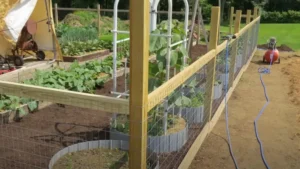







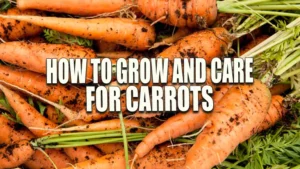

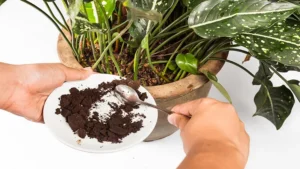
Leave your comment